How To Get Crystals Out Of Rocks
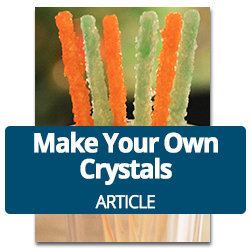
What are crystals and how do they form? With these crystals growing scientific discipline experiments, you lot will abound crystals of your own to find out more about these fascinating and beautiful wonders!
A crystal is a solid cloth with atoms and molecules that are arranged in a consistent repeating pattern, creating 1 of seven geometrical shapes. Crystals tin can be expensive and beautiful, like amethysts or diamonds. But they can also exist found right in your kitchen in the class of sugar and salt! You tin easily grow crystals by adding a crystal-forming chemic to water and waiting for the water to cool or evaporate.
Here you'll observe 5 different methods for how to grow crystals. Science experiments with instructions are provided for each. How does the chemical used affect the crystals grown? Which crystal growing science project is your favorite?
How to Grow Crystals at Dwelling

Table of Contents:
- Quick Crystal Cup
- Growing Gems
- Rock Candy Sticks
- Sparkly Crystal Ornaments
- Common salt vs. Carbohydrate
- Taking Information technology Further
- Crystal Growing Science Kits
Crystal Growing Science
Quick Crystal Cup
Some crystal growing science projects can take several days. Simply this super-easy recipe gives yous a loving cup full of needle-like crystals in just a few hours!
What Y'all Need:
- Purchase magnesium sulfate (Epsom common salt)
- Food coloring pack
- 250 ml beaker
What You Do:
- In the beaker, stir 1/2 loving cup of magnesium sulfate with 1/2 cup of very hot tap water for at least one minute. This creates a saturated solution, meaning no more than salt can deliquesce in the water. (Some undissolved crystals volition exist at the bottom of the glass.)
- Add a couple drops of nutrient coloring if you want your crystals to exist colored.
- Put the beaker in the refrigerator.
- Bank check on it in a few hours to come across a chalice full of crystals! Pour off the remaining solution to examine them.
What Happened:
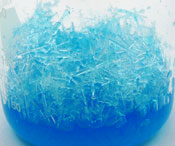
Epsom table salt is another proper noun for the chemical magnesium sulfate. The temperature of the water determines how much magnesium sulfate information technology can hold; it will deliquesce more when it is hotter. Cooling the solution rapidly encourages fast crystal growth, since there is less room for the dissolved salt in the cooler, denser solution. Equally the solution cools, the magnesium sulfate atoms encounter each other and join together in a crystal structure. Crystals grown this manner will be modest, thin, and numerous. To grow big unmarried crystals, you'll need to follow the evaporation procedure in the adjacent project.
Dorsum to summit ^
Crystal Growing Science
Growing Gems
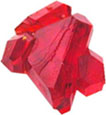
Y'all tin abound single, large crystals that expect like gems by using a seed crystal. Here'southward how to do it:
What You lot Need:
- Alum (you lot can oft detect this in the spice aisle of the grocery shop)
- Clean 250 ml beaker or jar
- Saucer or shallow dish (plastic petri dishes works, besides)
- Pencil
- Fishing line
What Yous Exercise:
ane. In ane 250 ml beaker, slowly add together alum to 1/4 cup of very hot tap h2o, stirring to deliquesce. Keep adding the alum until no more volition dissolve: this is a saturated solution. Pour a little bit of this solution into a shallow dish or saucer and permit information technology sit undisturbed overnight. Brand sure you lot only pour the clear solution, not whatsoever of the undissolved textile. (Yous tin pour it through a java filter if necessary.)
2. The adjacent day you should meet pocket-sized crystals growing in the dish. When they await to be a good size, carefully pour off the solution.
3. Brand another saturated alum solution with about 1/ii cup of hot water. Pour the solution into a make clean beaker or jar; avoid pouring any undissolved material.
4. Remove the biggest and best-looking of the pocket-size crystals from the saucer to utilise as your seed crystal.
5. Get someone to help yous necktie the line-fishing line to the seed crystal. This can be tricky; a pair of tweezers will help! If you demand to, y'all can score a groove in the crystal to hold the line in place.
6. Tie the other finish of the angling line to a pencil, and then set up the pencil across the elevation of the jar so the seed crystal is suspended in the alum solution without touching the sides or bottom of the jar. (You may need to adjust the length of the fishing line: just wrap it around the pencil until it is the right length.) Notation: if your seed crystal starts to deliquesce, that means your solution isn't saturated enough. Remove the seed rapidly and add together more alum to the solution, filtering off any undissolved particles.
7. Cover the jar with a paper towel to go on out the dust and permit your crystal grow until you lot are happy with its size. When you take it out of the solution, set it on some plastic wrap to dry.
Notation: if you see other crystals growing in the jar, transfer the solution and seed crystal to another clean jar.
What Happened:
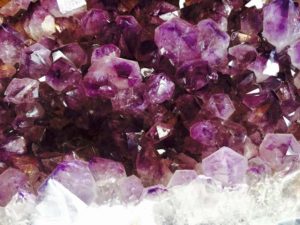
The small crystals that formed in the saucer grew because of nucleation. A few alum molecules constitute each other in the solution and joined together in a crystal blueprint. Other alum molecules continued to join them until enough molecules gathered to become a visible crystalline solid. (Chemists call that a crystal "falling out of" the solution.) If you left these crystals in the solution they would proceed to grow, but they wouldn't get very big considering they would all be competing for the remaining alum molecules in the solution. Instead, you took one crystal and used it every bit the only nucleation site in the solution. It was the main site for the alum molecules to join together, and then the crystal could grow quite big!
Back to top ^
More Crystal Growing Scientific discipline:

- Brand Your Own Geode
- Create Stalactites & Stalagmites
- Crystals Science Lesson
Crystal Growing Science
Rock Candy Sticks
Become ready to sentry some cool crystals abound! And when y'all're done, you lot can eat them or requite them abroad every bit Christmas gifts! Click here to download a rock candy crystals printable.
What You Need:
- 1 1/2 cups of white sugar
- ane cup of h2o
- Small plate
- A spoon
- A glass
- Wax paper
- Saucepan
- Stove
- Several 250 ml beakers or minor clean jars
- Cake popular sticks or wooden skewers
- Food coloring pack (optional)
- An adult to assist you lot
Note: You can make Rock Candy without sticks. Use a piece of clean cotton wool string or thread. Follow steps 2-seven below and so dip the string into the solution so that one-half of the string is coated. Take the string out and let it dry. Once the string has dried, tie the clean terminate around a pencil and put the dipped stop dorsum into the glass of saccharide water solution, balancing the pencil across the rim of the glass. Make sure the string does not touch on the bottom or the sides of the glass, or your crystals volition non form right! When your piece of "stone processed" is as big every bit you want it to be (about one calendar week), take it out of the glass, let it dry, and enjoy!
1. Make full a glass with h2o, pour some sugar on a pocket-sized plate, and lay out a sheet of waxed paper. Dip one end of each stick (cut pointed ends off if y'all use skewers) into the h2o and then coil it in the sugar, tapping it gently to remove excess. Set each stick to dry on the waxed paper.
2. Pour the cup of h2o into the saucepan and add 1/two cup carbohydrate. Stir it well until no more than sugar will dissolve. Add more than sugar (1/2 cup at a time) until you can't get whatsoever more to dissolve even after stirring for several minutes. You should end upwards with about one 1/2 cups sugar dissolved in the saucepan. It'southward OK if there is some undissolved saccharide at the bottom of the pan. (You now have a saturated carbohydrate solution.)
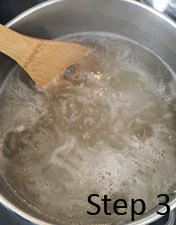
3. Ask an adult to aid y'all rut the sugar mixture on the stove until it boils, stirring the whole time. Turn the heat to medium-low and keep stirring until all the sugar dissolves. (Now yous take made a supersaturated solution!)
iv. Go along cooking the liquid and stirring it until it becomes clear, but not for more than 5 minutes, or it will get too hot and plow into hard candy! Turn off the stove as shortly equally it starts to look clear.
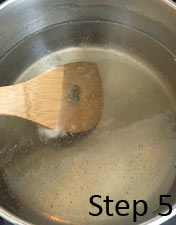
5. Move the pan off the oestrus and allow it to cool down until the pan is no longer hot (the sugar solution will nonetheless be slightly warm).
6. Accept an developed slowly cascade the thick sugar solution into the jars. Fill each near 2/three full, or plenty so that saccharide solution volition cover several inches of your saccharide-coated sticks.
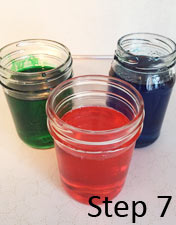
7. Add 5-6 drops of food coloring to each jar and stir. (Optional: Only practice this step if you lot want to make unlike colors of stone processed!)

8. Once the solution is cool and the sugar-coated sticks are completely dry, place several sticks into each jar.
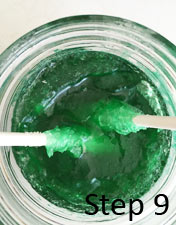
nine. Advisedly move the jars to a place where they won't be disturbed. Check them every other twenty-four hour period and gently stir the sticks around in the sugar solution to break upwardly whatever large crystals forming on the surface.
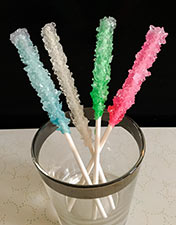
ten. Inside a few days, you lot should start to encounter crystals growing on the sticks. After about one calendar week, you volition probably have a lot of crystals. When your "stone candy" crystals are as big equally you lot desire them to exist, take them out of the jars and set up each colour of candy in a clean glass to dry out.
11. Once they are dry, you can wrap in cellophane food wrap and tie with ribbon for a sugariness Christmas gift!
What Happened:
In stride 2 yous made a saturated solution—there was so much sugar in the water that it couldn't deliquesce any more sugar and some was left in the bottom of the pan. Once the saturated solution started to heat up, the water was able to deliquesce even more sugar and a supersaturated solution was formed in step three. Then, equally the solution cooled, the saccharide molecules in it started to join with the sugar molecules on the sticks. The saccharide on the sticks are called "seed" molecules and the sugar molecules in the solution attached themselves to the seed molecules.
Meanwhile, the h2o in the solution started to evaporate or dry up into the air, leaving simply sugar molecules behind. More sugar molecules gradually joined with the ones already on the stick, forming larger crystals. Because all of the solute molecules are the same (they are all sugar), they all form the same shape of crystals and they all stick together, making a big chunk of carbohydrate crystals that are pretty to look at and tasty to swallow!
Notation that this is a special scientific discipline project that is safe to consume because you only used food products, non chemicals. Plus, y'all used clean dishes from your kitchen. Never eat any experiment unless it is made entirely out of food and you merely used clean dishes to prepare it!
Dorsum to top ^
Crystal Growing Science
Sparkly Crystal Ornaments
In this projection, you use a chemical called Borax to grow crystals shaped like snowflakes, stars, or candy canes. Then y'all can utilize them as pretty decorations!
What You Need:
- Wide-oral fissure jar
- Pipe cleaners
- Cord
- Scissors
- A pencil
- Water
- 1-cup measuring cup
- Tablespoon
- Borax
- Food coloring (optional)
- Glow-in-the-dark paint (optional)
- Ribbon (optional)
What You Do:
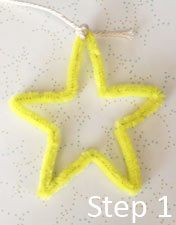
1. Twist pipe cleaners into whatever shape y'all'd like (nosotros chose a unproblematic star). Notation: Make sure your pipe cleaner shape will fit easily into your jar with enough of space around the oral cavity of the jar every bit the shape will be slightly wider one time crystals accept formed on it, making it harder to remove!
2. Tie a piece of string to one point of the shape. Tie the other end around the middle of a pencil.
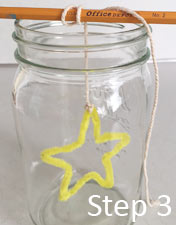
3. Hang the shape in the jar with the pencil resting across the mouth of the jar. Make sure that it hangs without touching any office of the jar. Have it out of the jar and prepare it bated.
4. Use a i-loving cup measuring cup to count how many cups of h2o you need to fill your jar about 3/four full. Then microwave the jar of water for 3-5 minutes or until it begins to boil. Take an adult carefully take the jar out using hot pads (the jar volition be very hot!) and set it on a estrus-condom surface.
5. For every cup of water you put in the jar, measure 3 tablespoons of Borax. Stir the Borax solution with a spoon until equally much of it dissolves equally is possible. If you don't run into any tiny pieces of Borax floating around in the jar, add another tablespoon and stir. This will make a saturated solution.
6. Hang your pipage cleaner shape in the jar so that it is completely covered in the solution. Permit it sit down overnight. Gently remove your now crystal-covered shape in the morning time and let information technology dry by setting information technology in a dry out glass.
7. Optional: To make colored crystals, use colored pipe cleaners and add 5-10 drops of food coloring to the solution in step five. To make your snowflakes glow in the dark, pigment the pipe cleaner shape with glow-in-the-nighttime paint in stride ane and permit it dry completely before continuing. Once the crystals have dried, cutting off the cord and necktie a ribbon to i point of your crystallized shape to make a Christmas tree ornament! These ornaments are fairly sturdy and make lovely Christmas gifts for friends, teachers, or family members.
What Happened:
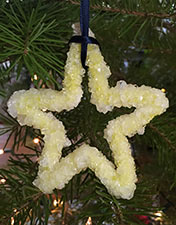
As in the rock candy project, you made a saturated solution of Borax, which is a chemical that forms crystals when the conditions are right. By mixing it with hot h2o and letting it cool and having something for the Borax (solute) molecules to adhere to (the pipe cleaner shape), you gave the solution the correct atmospheric condition to grow crystals! Once the crystals started to grow on your shape, more and more crystals formed around them. Ice crystals that real snowflakes are made of are not quite like these Borax crystals, simply they do wait sort of similar and they both are pretty and sparkle when calorie-free shines on them.
Existent ice crystals are made only of water. The difference is that they are formed when water vapor in clouds freezes and falls to the ground equally snowflakes! Frost is another form of ice crystals that you might run across on windows and grass on cold mornings. To acquire more than virtually snow and water ice crystals, check out our Snow and Hail article.
Back to top ^
Crystal Growing Science
#5: Salt vs. Sugar
How can you tell the departure between saccharide and salt crystals? They're both crystals and they await very similar—they are both pocket-sized, white-colored grains. Of course if y'all tasted each of them, you would know correct away which one was salt and which was carbohydrate because they taste very different. In this projection you volition find out how to tell sugar and common salt autonomously merely past looking at them!
What You Need:
- A teaspoon of tabular array salt
- A teaspoon of white granulated carbohydrate
- Two sheets of black construction paper
- A minor magnifying glass
- Crystals worksheet
What Yous Practise:
1. Put a teaspoon of salt on one sheet of black paper and a teaspoon of sugar on the other.
2. Apply your fingers to spread the grains apart a little then you can see them improve. At present await closely at the grains on each canvas of paper and compare how they wait. Practise you notice any differences between the ii?
3. Now employ your magnifying glass to await up close at a few grains of the table salt. What shape are they? Are they all nearly the same shape? Draw their shape in the correct spot on the worksheet.
4. Now take a look up close at a few grains of the sugar. What shape are they? Are they a different shape from the salt crystals? Do y'all observe anything else that makes them wait unlike from the table salt? Describe their shape on the worksheet.
What Happened:
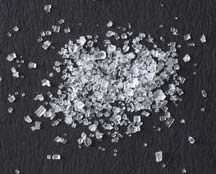
Carbohydrate and common salt grains are actually tiny crystals. Can you lot tell if the picture show to the left is salt or saccharide? It's sugar!
If you were to brand a saturated solution of salt and one of sugar, you would be able to see them grow into much larger crystals, but they would always have the same shape equally these tiny crystals do! The salt crystals are cube shaped (like dice) and have half dozen sides. The sugar crystals are very rough looking and are shaped more like rectangles with pointed ends.
Most of the crystals are the same shape and size and look very similar to each other, but you probably saw a few crystals on your paper that looked a little dissimilar. Those crystals probably had pieces broken off of them, or there might fifty-fifty be more 1 crystal stuck together, making them look dissimilar from the others. Also, the coloring of the crystals is a piddling different. Sugar crystals look very clear and sparkly while salt is duller and looks more white-colored or frosted.
Back to elevation ^
Crystal Growing Scientific discipline
Taking It Farther
In that location are many factors that affect crystal growth, so crystal projects are great for scientific experimentation and science fairs. For example, many crystals are formed considering of evaporation. Temperature and humidity are two things that touch the charge per unit of evaporation, so y'all could pattern an experiment to come across how dissimilar temperatures and humidity levels affect the rate of crystal growth and the size of crystals. Another aspect to test is the rate at which your solution is cooled: if yous make a solution with humid water, will crystals grow meliorate if it's allowed to come up to room temperature slowly or if it's cooled in the refrigerator?
There are many substances that tin be used to grow crystals. You could design an experiment to test which i grows larger crystals under the same conditions. Effort alum, Epsom salt, table salt, sugar, baking soda, or not-household chemicals like copper sulfate (blue crystals) and potassium ferricyanide (cherry crystals); developed supervision is required for the final two.
Back to top ^
How To Get Crystals Out Of Rocks,
Source: https://learning-center.homesciencetools.com/article/crystal-growing-science/
Posted by: bergerfaids2000.blogspot.com


0 Response to "How To Get Crystals Out Of Rocks"
Post a Comment